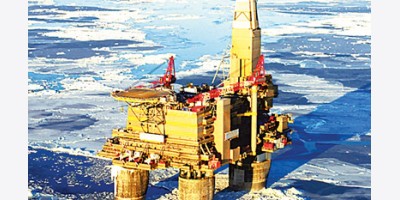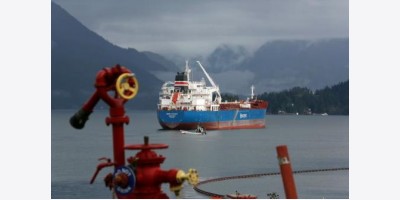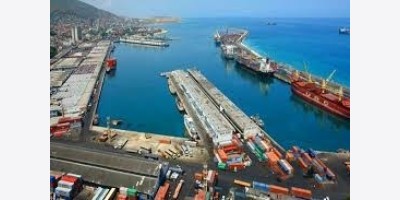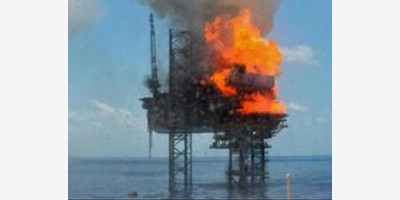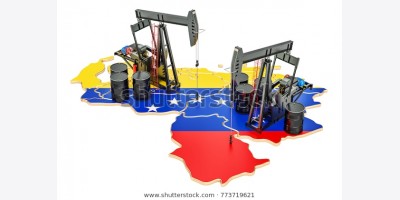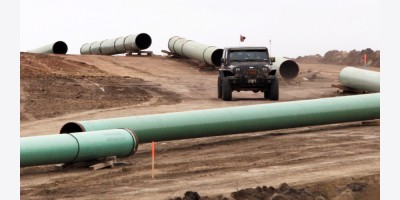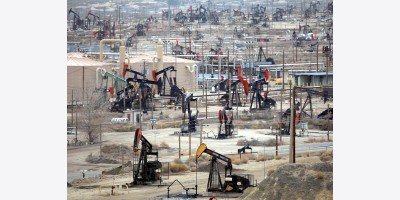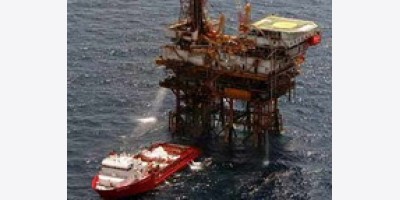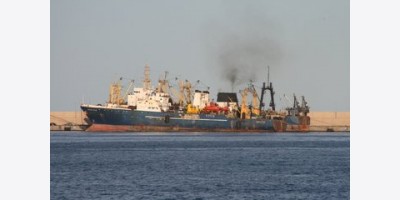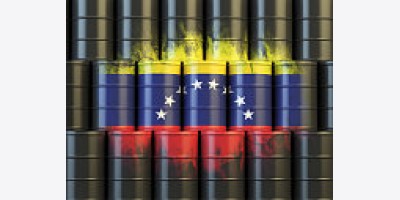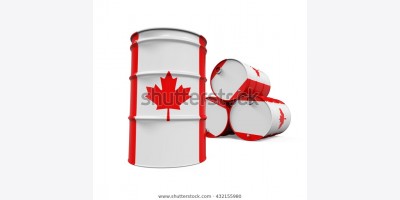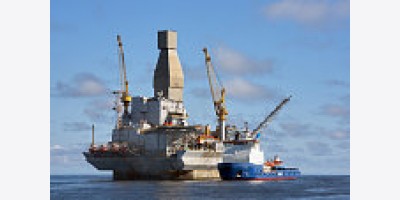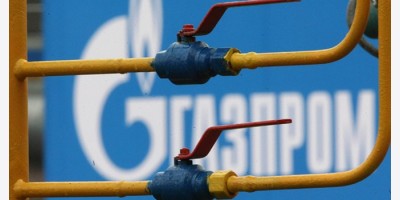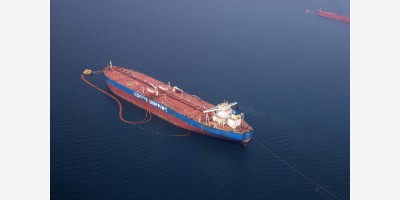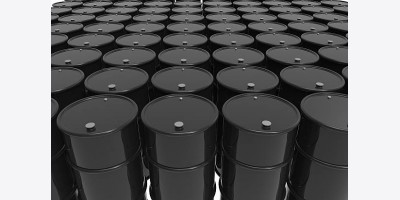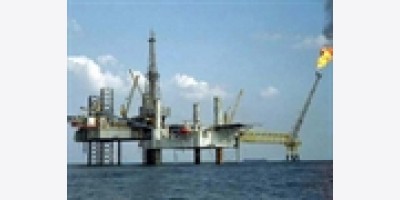Total provisional Sep 1-6 Urals exports up 538,635 b/d on Aug at 2,225,635 b/d
Loadings of Urals crude out of the Baltic Sea ports of Primorsk and Ust-Luga and the Black Sea port of Novorossiisk in the first six days of September are set to jump by 538,635 b/d over the same period in August, according to a copy of the preliminary loading schedule for the grade seen by Platts Friday.
The combined average daily loading rate at the three ports is set to surge to 2,225,635 b/d September 1-6, up from 1,687,000 b/d over the first six days of August. The final August loading program was one of the tightest in more than two and a half years, according to Platts data. Loadings out of Novorossiisk are set to almost double over the first six days of September, climbing by 247,000 mt to 547,000 mt.
The August program out of the Black Sea terminal was the tightest since at least January 2012, with only three Urals cargoes scheduled — two Aframaxes and one Suezmax — to load across the first week of the program.
The September schedule, by contrast, currently has two Suezmax cargoes of 140,000
mt each and three Aframax cargoes of 80,000 mt scheduled over the first six days. An additional volume of 27,000 mt of small producers’ equity is included in the provisional schedule, and may be incorporated into another cargo at a later date.
Provisional schedules are subject to change. Daily loadings at the terminal are currently scheduled to average 659,135 b/d, up from 361,500 b/d over the same period in August. Exports are also set to increase by 100,000 mt each at both the Baltic Sea terminals of Primorsk and Ust-Luga to 800,000 mt and 500,000 mt respectively.
Primorsk, which typically sees the largest export volume of the three main terminals is set to load eight 100,000 mt over the first six days of September at an average daily loading rate of 964,000 b/d. Loadings at nearby Ust-Luga are set to average 602,500 b/d across five cargoes of 100,000 mt each.
No cargoes of Siberian Light crude are currently scheduled to load out of Novorossiisk out of the early part of September, down from the one in the first 10 days of both August and July. Typically, two to three cargoes a month of Siberian Light load from Novorossiisk. The final full August loading program had four, evenly distributed across the calendar.
Global refiners struggle to keep pace with US
With global product markets relatively weak, refiners in most regions outside the US are finding it difficult to turn a profit despite easing supply balances.
This has led Asian refiners to look further afield for quality crudes, which are steadily becoming more ample, weighing on differentials and flat price alike as front-month ICE Brent continues to slide. Brent fell below $102/barrel this week from over $115/b in June. October Brent settled at $103.53/b Friday.
For example, Platts data shows Singapore cracking margins for nearly 15 crudes have been negative over the last several months, even as values tumble for crudes like Sudan’s Dar and Nile Blends, Indonesian Minas and Russian ESPO. Platts margin data reflects the difference between a crude’s netback and its spot price.
Netbacks are based on crude yields, which are calculated by applying Platts product price assessments to yield formulas designed by Turner, Mason & Co. Differentials for Sudan’s Dar Blend in Singapore were assessed at an over-$14/b discount to Asian Dated Brent Friday, almost $4/b below their 30-day moving average.
Likewise for Nile Blend, which was assessed in Singapore at a more-than-$11/b discount Friday, almost $7/b below its 30-day moving average. While Platts does not provide margin data for these grades, data for imported grades like Saudi Arab Light and Angolan Cabinda show that Singapore refiners are having a hard time operating in the black.
By comparison, cheap North American crudes have kept US refining margins well above par compared to other regions, but so has the availability of a massive export market for refined products, as US Gulf Coast refinery yields for exportable products far surpasses yields for similar grades in either Northwest Europe or Singapore.
Lower operating costs are also a significant advantage for US refiners, which are largely driven lower by the abundance of cheap and available natural gas and related NGLs. The cracking yield for Saudi Arab Light on the USGC is just over $110/b on a 30-day moving average. In Northwest Europe that same grade yields just $107.70/b over a similar period. Singapore yields for Arab Light are even worse, coming in at $104.56/b.
The situation is similar for Angola Cabinda, a spot crude available to all three markets. Cabinda yields around $112.77/b on the USGC, $108.36/b in Northwest Europe and just $105.06/b in Singapore. But strong yields do not necessarily reflect strong margins, as margin calculations include the spot price of a given crude.
Eland Oil & Gas signs farm-in agreement for Nigeria’s Ubima field
West Africa-focused Eland Oil & Gas has raised its portfolio in Nigeria with a $10 million acquisition of 40% of the Ubima oil field onshore the Niger Delta. The company said Friday Eland’s wholly owned subsidiary Wester Ord Oil & Gas has agreed to pay Allgrace Energy a $7 million signature bonus, once ministerial consent has been given, and a $3 million production bonus.
The field, in the Rivers state, is estimated to hold 34 million barrels of oil with a major potential upside in the form of 3C resources of 66.9 million barrels. Ubima has 3D seismic coverage and four wells have been drilled in the field between the 1960s and 1981 with hydrocarbons discovered in all four. Wester Ord believes that subsequently an initial four development wells
can be drilled and put into production 9 to 12 months from commencement of the full work program which it estimates will cost $125 million. The field is close to and existing crude oil pipeline and discussions are ongoing with its owner Shell to use the infrastructure.
Think-tank warns majors of oil price risk to high-capital projects
Oil majors should consider delaying or canceling projects that require a high oil price, and instead focus on low-capital investments, an environmental think-tank said Friday in a report. London-based Carbon Tracker Initiative said that collectively, the world’s oil majors had a potential capital spend of $548 billion over the period 2014-2025 on projects that require
a market price of at least $95/b. It said that some $357 billion of this is on high-cost projects that are yet to be developed. “Such projects are candidates for deferral or cancellation,” CTI said. The report looked at the planned capex of BP, Chevron, ConocoPhillips, Eni, ExxonMobil, Shell and Total. “Investors may wish to push companies for more detailed disclosure of project level economics, and challenge developments that carry an undue risk of wasting capital and destroying value,” it said. Oil majors are increasingly focused on cost discipline and a number of projects have already either been deferred or re-examined to find cost savings. Total recently made much of the fact that it had been able to move forward with the giant Kaombo project offshore Angola because it had found $4 billion in cost savings — reducing the overall budget from $20 billion to $16 billion. The majors’ portfolios include several significant Arctic and deepwater/ultra-deepwater projects that could prove low return assets in a low-demand scenario, CTI said. “In order to sustain shareholder returns, companies should focus on low cost projects, deferring or canceling projects with high breakeven costs,” it said. It pointed to examples where companies have already revised investment plans, particularly in the Canadian oil sands sector. In 2014, Total and Suncor shelved the $11 billion Joslyn project while Shell put on hold its Pierre River project. Deepwater projects have also been deferred. BP is not proceeding with its Mad Dog extension in the Gulf of Mexico, Chevron is reviewing its $10 billion Rosebank project in the North Sea and in the Arctic, Statoil and Eni have deferred a decision on the $15.5 billion Johan Castberg project.
Canadian heavy crude exports up 150,000 b/d through May
Exports of Canadian heavy crude jumped by 150,000 b/d through the first five months of the year to average 1.974 million b/d, according to data from Canada’s National Energy Board.
The data, released late Thursday afternoon, showed Canadian exports topped 2 million b/d in two of the first five months, including the 2.029 million b/d it reached in May.
Canadian heavy crude exports have risen each of the past four years and have nearly doubled over the past decade. Exports in 2004 averaged only 1.023 million b/d.
Prices for these grades have climbed commensurately, with heavy crude cost at netback location averaging C$86.69/b ($79.48) through May this year, up from only C$75.52/b the first five months of 2013.
At C$92.87/b, May crude exports hit the highest price since August of last year, when it reached as high as C$96.24/b. The change has proven less dramatic for light crude exports, up only 17,000 b/d year over year at an average of 796,000 b/d through May.
By Moming Zhou Aug 18, 2014 6:00 AM GMT+0700
Refinery breakdowns from Kansas to Texas are giving gasoline a boost, spurring speculators to increase bullish bets for the first time in six weeks as the Labor Day holiday approaches.
Hedge funds raised net-long positions by 13 percent in the week ended Aug. 12, Commodity Futures Trading Commission data show. The wagers slumped 56 percent in the previous five weeks, while gasoline futures dropped 10 percent since the Memorial Day holiday on May 26, the traditional start of the driving season.
Bets on rising prices reached this year’s high in late April on speculation that peak summer demand would reduce supply. Inventories expanded to a four-month high in July, as refineries produced a record amount of fuel and consumption was stuck at the lowest seasonal level since 2012. The outages are unlikely to stem a decline in prices, according to AAA.
“The refinery outages spurred some buying,” John Kilduff, a partner at Again Capital LLC, a New York-based hedge fund that focuses on energy, said by phone on Aug. 15, “It’s certainly still a bearish market. The demand environment is not great, and there is plenty of gasoline coming into the market. We remain well-supplied.”
Gasoline futures gained 1.9 cents, or 0.7 percent, to $2.7345 a gallon on the New York Mercantile Exchange in the period covered by the CFTC report. Prices fell to $2.6666 on Aug. 14, the lowest since Feb. 5, before rebounding 3.2 cents on Aug. 15 as crude oil rallied amid escalating tension between Ukraine and Russia.
Pump Prices
Regular gasoline at the pump, averaged nationwide, sank to $3.468 a gallon Aug. 14, according to Heathrow, Florida-based AAA, the largest U.S. motoring group. The peak driving season typically runs through Labor Day, which falls on Sept. 1 this year.
“Refineries are making more than enough gasoline to meet domestic demand, which has helped push gas prices to the lowest level for this time of year since 2010,” Michael Green, a Washington-based AAA spokesman, said by e-mail Aug. 14. “It seems unlikely that an increase in road trips over Labor Day weekend would reverse this summer’s gas price decline based on current conditions.”
A fluid catalytic cracker at Exxon Mobil Corp.’s 344,600-barrel-a-day Beaumont, Texas, refinery was shut after a malfunction July 25. CVR Energy Inc. (CVI) closed the 115,000-barrel-a-day Coffeyville refinery in Kansas after a July 29 fire.
Refinery Rates
U.S. refineries operated at 91.6 percent of capacity in the week ended Aug. 8, down from 93.8 percent in July, according to the Energy Information Administration. Gasoline production was 9.52 million barrels a day, the most for this time of year since since EIA began weekly data in 1982.
Demand averaged 9.02 million barrels a day in the four weeks ended Aug. 8, the lowest seasonal level since 2012, according to the EIA, the Energy Department’s statistical arm. Inventories rose to 218.2 million barrels as of July 25, the most since March.
“Stocks are ample, output is rising and demand will see structural decline for years.” analysts at Bank of America Corp. including Francisco Blanch, the bank’s head of commodities research in New York, said in a report Aug. 12.
Global refining capacity rose to a record 94.9 million barrels a day by the end of 2013, according to BP Plc’s Statistical Review of World Energy. U.S. capacity reached a record 17.9 million this year, according to the EIA.
More Capacity
“Too many refiners and too little demand, and that’s the problem,” Robert Campbell, the New York-based head of oil products research at Energy Aspects Ltd., a London-based research firm, said by phone Aug. 14. “Refining capacity worldwide continues to grow rapidly relative to demand.”
Hedge funds and other money managers boosted net-long positions in gasoline by 3,752 futures and options to 32,916 in the week ended Aug. 12, the CFTC said Aug. 15 in its weekly Commitments of Traders report. That’s the biggest increase since June. Long positions grew by 2,233 to 60,972, while shorts slipped by 1,519 to 28,056.
In other markets, bearish wagers on ultra low sulfur diesel shrank by 30 percent to 13,103 contracts. The fuel dropped 0.19 cent to $2.845 a gallon in the report week.
Natural Gas
Net longs on U.S. natural gas decreased 14 percent to 131,124 futures equivalents. The measure includes an index of four contracts adjusted to futures equivalents: Nymex natural gas futures, Nymex Henry Hub Swap Futures, Nymex ClearPort Henry Hub Penultimate Swaps and the ICE Futures U.S. Henry Hub contract. Nymex natural gas rose 7.7 cents to $3.974 per million British thermal units during the report week.
Net-long positions in benchmark West Texas Intermediate fell by 7.4 percent to 218,814 futures and options, the lowest since June 2013. WTI dropped 1 cent to $97.37 a barrel in the report week.
Crude jumped 1.9 percent on Aug. 15 after Ukraine said its forces attacked and partially destroyed a convoy entering the country from Russia.
“It’s a fundamentally bearish market, subject to all the geopolitical uncertainties that we have no control over,” said James Williams, an economist at WTRG Economics, an energy-research firm in London, Arkansas, by phone Aug. 15. “Refiners have been running at a pretty high rate, and demand has been weak. We are probably in for more continued weakness.”
By Jeremy Kahn Aug 18, 2014 3:01 AM GMT+0700
On a May afternoon in Tehran, a Russian in a dark suit sits in the crowded lobby cafe of the Espinas Persian Gulf International Hotel with his Farsi translator, sipping coffee with potential Iranian partners while discussing the price of soy fiber. No sooner do they vacate their armchairs than another group of besuited businessmen takes their place, this time conversing in Italian and Farsi about industrial motors.
The Espinas, one of Tehran’s few luxury hotels, opened in 2009, just as successive rounds of sanctions over Iran’s nuclear program were drawing an ever-tighter noose around the economy. With the restrictions biting, the Espinas’s lobby, adorned with pink-granite columns and faux Achaemenid sculptures, emptied out.
Today, however, amid glimmers that sanctions will be lifted, finding a room at the Espinas isn’t easy, Bloomberg Markets magazine will report in its September issue.
“All the five-star hotels are full of Western companies looking to position themselves to do business -- and also Japanese and Chinese companies,” says Sarosh Zaiwalla, a London-based lawyer who specializes in sanctions regulation and who travels frequently to Tehran.
Iran has seen a huge surge in the number of Western business delegations, says Amir Cyrus Razzaghi, the head of Ara Enterprise Group, a consulting firm in Tehran that provides market research and business intelligence to clients.
Closed Market
In February, a group representing more than 100 French companies -- including engineering group Alstom SA (ALO), telecommunications company Orange SA (ORA) and carmaker Renault SA (RNO) -- visited Tehran, the largest foreign-trade mission the country had ever hosted. Groups from Canada, Europe and the U.S. have also come. Companies that were once active in Iran, such as French oil giant Total SA (FP) and Luxembourg-based ArcelorMittal (MT), the world’s largest steelmaker, have publicly expressed interest in returning.
Iran -- one of the world’s largest closed markets -- may be on the verge of opening for business after years of isolation, says Charles Robertson, chief economist at Renaissance Capital Ltd., a London-based investment firm.
“This is the last major opportunity out there in the world that can suddenly become accessible, almost overnight,” he says.
Robertson, who visited Tehran in February, compares Iran to Turkey in 2004, when that emerging market was poised for what turned out to be almost a decade of strong economic growth.
Diplomatic Breakthrough
What’s raised investor expectations about doing business there is a diplomatic breakthrough that could clear the way for sanctions to be lifted. Brokered with Iran in November by the U.S., China, Germany, France, the U.K. and Russia, the deal eased some sanctions temporarily in exchange for Iran’s commitment to curtail uranium enrichment and allow greater oversight by the International Atomic Energy Agency.
The Joint Plan of Action, or JPA, released $4.2 billion in Iranian funds frozen in foreign banks and suspended sanctions on petrochemical exports, gold trading, the sale of goods and services in the automotive industry, and the supply of parts and maintenance needed to keep Iran’s civilian aircraft flying safely.
Iran has been struggling under layers of sanctions laid down as thick as paint on an old barn by the U.S., the European Union and the United Nations over more than three decades.
Final Settlement
The U.S. measures, some of which date back to the Iranian Revolution in 1979, are the strictest. U.S. citizens are barred from doing any business with Iran without a waiver from the U.S. Treasury. Foreign companies that trade with Iran risk being fined and cut off from the U.S. market, a threat that has driven many European firms to abandon Iran in recent years.
The UN sanctions primarily target individuals and entities directly tied to Iran’s nuclear program, while EU sanctions have tightened and broadened over time to include Iranian oil sales and banking.
The November JPA set a July 20 deadline for a final settlement on Iran’s nuclear program. As the clock ticked down, that deadline was pushed out to Nov. 24. The extension freed up an additional $2.8 billion of Iranian money that had been frozen in foreign bank accounts.
Meanwhile, in July, as Israel and Iran-backed Hamas forces in Gaza exchanged missile fire in another outbreak of fighting, Israeli Prime Minister Benjamin Netanyahu warned the U.S. against doing a “bad deal” with Iran.
Oil Reserves
Other events in the region, however, have drawn Iran and the U.S. closer together. With Syria’s civil war spilling over into Iraq, the U.S. and Iran both rushed to help Iraqi forces counter the threat posed by Sunni extremists. If a conflagration disrupts Iraqi oil production, Iran’s reserves, the fourth largest in the world, will become important to world markets.
Iran has 76 million people, about the same number as Turkey. As recently as 2011, it produced twice as many cars as Turkey, according to the Paris-based International Organization of Motor Vehicle Manufacturers. It consumes more steel annually than either the U.K. or France, according to the World Steel Association. And the Tehran Stock Exchange, or TSE, has a market capitalization of about $135 billion, three times the value of the main stock market in Vietnam, with a population of 89 million.
While once-embargoed markets such as Myanmar and Libya lack developed financial markets and physical infrastructure, Iran has both, Robertson says -- presenting an opportunity that’s “just huge.”
‘Long-Term Potential’
The man who helped organize Robertson’s trip to Iran is Ramin Rabii, the managing director of Turquoise Partners Group, a Tehran-based investment firm with $200 million under management that has become the first port of call for investors.
“This is one of the most attractive markets in the world in terms of its long-term potential,” Rabii says.
Turquoise was set up in 2005 to provide an easy way for foreigners to invest in the TSE. Sanctions, however, put an end to that in 2010. Since the JPA was signed, Rabii says, he’s received half a dozen e-mails a week from investors looking for more information on the market.
Most sanctions remain in place. And if businesses eying Iran needed any reminder of the force of those measures, they got one on June 30 when BNP Paribas SA (BNP), France’s largest bank, agreed to pay a record $9 billion for violating U.S. sanctions on Iran, as well as on Sudan and Cuba.
‘Plan in Place’
Still, companies -- particularly those that sell pharmaceuticals, medical devices and consumer goods already subject to fewer restrictions -- would be foolish not to draw up contingency plans to enter the market if sanctions are lifted, says Matthew Spivack, a London-based consultant at Frontier Strategy Group.
“Not having a plan in place, not thinking about it, is what will really put you behind,” he says.
Among those that have publicly expressed interest in Iran is Canadian transportation company Bombardier (BBD/B) Inc.
“Our role right now is to understand when sanctions could be lifted and how we could take advantage of a market we feel will be important for all of our products,” Pierre Beaudoin, Bombardier’s chief executive officer, said at a news conference after the company’s annual meeting on May 1.
Beaudoin’s bland statement belies the bounty of contracts that could await a company such as Bombardier if Iran opens up.
The Iranian government has said it’s looking to buy 400 passenger planes -- including regional jets and turboprops -- in the next 10 years to upgrade its aging fleet. (On August 10, a domestically produced Iran-140 turboprop aircraft, a copy of a Ukranian Antonov AN-140, crashed shortly after takeoff from Tehran, killing 48 people.)
Jockeying to Return
Bombardier could compete for some of that business. The Tehran government has also unveiled plans to spend $10 billion improving the capital’s public transport system during the next five years, including buying 2,300 metro-rail cars, which Bombardier also produces.
Companies based in Europe, many of which departed Iran only in the past four years as sanctions tightened, have been most conspicuous in jockeying to return -- leaving U.S. firms behind.
‘Getting Lapped’
“There is a sense that they are getting lapped by the Europeans,” says Reza Marashi, research director of the Washington-based National Iranian American Council, which represents the interests of Americans of Iranian descent in the U.S. “The Europeans didn’t sanction themselves out of influence in Iran like we did.”
Asked at a press conference about U.S. criticism of French businesses, including Total, that have held exploratory talks with Iran, Total CEO Christophe de Margerie said, “When it becomes legal to work in Iran and contractual terms are satisfactory, I don’t see why Total would deprive itself of the possibility to beat out its Anglo-Saxon competitors in Iran.”
Iran’s overtures to investors date from President Hassan Rouhani’s election in July 2013. Rouhani succeeded Mahmoud Ahmadinejad, an anti-U.S., anti-Israel populist who had accelerated Iran’s uranium enrichment efforts. Ahmadinejad bequeathed to Rouhani an economy crushed by international sanctions.
Plunging Rial
By the summer of 2013, oil production had fallen to a 20-year low of 2.5 million barrels a day, down from a peak of 4 million barrels a day in 2008.
From the start of 2012 to Rouhani’s election, the Iranian rial plunged more than 60 percent against the dollar as inflation spiraled out of control, the U.S. prohibited international banks from trading or holding rials, and Iranians rushed to buy gold and foreign currency.
Real gross domestic product fell 5.6 percent in 2012 and a further 1.7 percent in 2013. The economy is forecast to grow 1.5 percent this year, according to the World Bank.
Rouhani has cast aside the Ahmadinejad playbook. At the World Economic Forum in Davos, Switzerland, in January, Rouhani invited CEOs and financiers to “come and visit Iran to see the investment opportunities.”
‘Personally Impressed’
Martin Sorrell, CEO of WPP Plc, the world’s largest advertising and marketing services group, was among several CEOs who met privately with Rouhani at the ski resort.
“I personally was impressed,” Sorrell says. “It seems he is bent on changing Iran’s relationship with the West.”
Sorrell says WPP has begun researching Iran’s business potential.
On August 10, Rouhani lashed out at hardline critics in his country who oppose negotiations with the West over Iran’s nuclear program.
“Fear of interaction, fear of negotiation and fear of understanding is wrong,” Rouhani said, according to the Iranian Students News Agency.
David Levine, a lawyer in the Washington office of McDermott Will & Emery who specializes in U.S. sanctions law, says companies exploring business opportunities in Iran should tread carefully.
“The downside risk is severe,” he says, citing penalties including prison and big fines.
Potential Backlash
Businesses also need to be wary of U.S. political pitfalls and public opinion, says Henry Smith, a Dubai-based senior consultant and Iran analyst at Control Risks Group Holdings Ltd., a consulting firm.
Fairfield, Connecticut–based General Electric Co. was so concerned about a potential public backlash to its work repairing engines on Iran’s civilian airliners -- a transaction authorized under the JPA and for which the U.S. Treasury has granted waivers -- that it promised to donate any revenues from the work to charity. (GE says Iran’s state-owned airline has yet to contact the company to start these engine repairs.)
Then there’s United Against Nuclear Iran, a New York–based group that pressures companies to cease doing business with Iran.
“This is a regime that sponsors terrorism and supports entities that maim and kill U.S. troops around the world,” says David Ibsen, executive director of UANI.
The biggest prize for Western companies is likely to be Iran’s energy industry. The government plans $100 billion in oil and gas projects over the next four years.
Energy Projects
Iran will need outside expertise to boost crude production significantly, says Robin Mills, head of consulting at Dubai-based Manaar Energy who traveled frequently to Iran as a Royal Dutch Shell Plc geologist in the 1990s.
Within weeks of the JPA announcement in November, Iranian Oil Minister Bijan Zanganeh met in Vienna with the chief executives of two oil and gas companies, Italy’s Eni SpA (ENI) and Austria’s OMV AG. In addition, Eni and Total have sent representatives to Tehran to discuss energy projects, says Akbar Nematollahi, the Ministry of Petroleum’s spokesman.
“Approximately every week, we have meetings with the delegations of these companies,” he says. “There have even been negotiations with some American companies. They are ready too.”
Nematollahi declined to name the U.S. firms.
In May, some 1,800 exhibitors crowded Tehran’s sprawling International Permanent Fairground for Iran’s annual International Oil, Gas, Refining and Petrochemical Exhibition. The petroleum ministry said 600 foreign companies attended, although many were small Chinese and South Korean firms.
Auto Companies
Jerome Budin, an international manager at Rotork Controls Ltd. (ROR), an electric valve–making subsidiary of Rotork Plc, a company based in Bath, England, was among the few Europeans staffing an exhibitor’s booth. Budin says Rotork has attended the fair for 12 years and sold products to Iranian petroleum, water and power companies after securing the necessary licenses.
“It’s quite a big market for us,” Budin says. “Obviously, we are looking forward to an easing of the sanctions.”
Western auto companies are also revving their engines over Iran. In 2013, even though U.S. sanctions on the auto industry were still firmly in place, Iranians bought more than half a million new vehicles, according to the International Organization of Motor Vehicle Manufacturers; most of those were domestic models manufactured by Iran Khodro Co. and Saipa Automotive Manufacturing Group.
Iranian Partners
In January, Renault CEO Carlos Ghosn told Bloomberg Television that this figure could increase threefold if sanctions were fully lifted. The JPA temporarily removed sanctions on the auto industry, and Renault, Europe’s third-largest automaker, has resumed shipping kits that its Iranian partners, Iran Khodro and Pars Khodro, assemble into vehicles. Renault had abandoned the market in 2012 because of sanctions.
Fellow French automaker Peugeot SA had been Iran’s leading car supplier, with a 30 percent market share, before it too withdrew in 2012. In the spring, Peugeot executives traveled to Iran to talk about coming back, spokesman Pierre-Olivier Salmon says.
The JPA’s temporary nature, along with continued banking restrictions, has kept the brakes on big business deals. Furthermore, despite the deadline extension, the two sides remain far apart on restrictions to Iran’s uranium enrichment capacity, and a final deal might prove elusive.
Uncertain Process
Even in the event of a deal, Control Risks’ Smith says, sanctions wouldn’t vanish overnight; they would probably be eased in phases tied to Iranian compliance. In the U.K. and U.S., for example, some sanctions can be lifted only if legislatures change the law, a time-consuming and uncertain process.
Many U.S. laws restricting trade with Iran predate concerns about Iran’s nuclear program and are related to Iran’s alleged sponsorship of terrorism and human rights abuses. Anti-Iran hawks in Congress may seek to keep restrictions in place—and lifting all U.S. sanctions is not under discussion, Smith says.
Mark Dubowitz, executive director of the Washington-based Foundation for Defense of Democracies, which advocates that Washington take a hard line on Iran, says he’s against allowing Iranian banks to participate in global finance too quickly, on grounds they have funded terrorism and laundered money.
“These are bad banks,” he says. “These banks should have to go through a long rehabilitation process where they demonstrate they are no longer a threat.”
Little Uplift
As for international banks seeking to do business in Iran, any eventual settlement will have to spell out what’s permissible.
In Tehran, for all the buzz in the Espinas lobby, the JPA has provided little economic uplift. Daily life for most of the capital’s 7.2 million people grows ever more difficult as food and fuel prices continue to rise. Iranians have little choice but to cling to the notion that things will get better, Ara Enterprise’s Razzaghi says.
“Very little concrete new business is being generated,” he says. “So, yes, people live in hope -- if only because the alternative is too terrible to contemplate.”
By Adam Williams Aug 16, 2014 3:35 AM GMT+0700
For Petroleos Mexicanos Chief Executive Officer Emilio Lozoya, the arrival of foreign oil producers after a 76-year hiatus can’t come soon enough.
Facing deteriorating output and a lack of resources to develop new finds, the 39-year-old former World Economic Forum executive said he’s in talks with all major producers as Mexico accelerates the opening of its oil industry. At the same time, he’s considering revising production estimates as water content rises at aging fields such as Cantarell, once the world’s third-largest deposit.
Lozoya is charged with transforming the state monopoly into a competitive enterprise under new rules allowing greater private investment. He’s seeking to reverse a decade-long production decline by establishing 10 joint ventures in mature, onshore and offshore areas by December 2015.
“The majors are interested mostly in investing in the deep waters in the Gulf of Mexico,” Lozoya said yesterday in an interview in Mexico City. “We do not necessarily have the expertise to develop those projects and bring them into production in a relatively quick period of time.”
After legislation passed in December to allow private investment in the oil industry, the government this week awarded Pemex rights to all the proved and probable oil reserves it sought for development as a part of Round Zero, as the non-competitive awarding of fields was known. Pemex retained fields holding an estimated 20.6 billion barrels, enough for the company to maintain production levels of at least 2.5 million barrels a day for the next 20 years, according to Energy Minister Joaquin Coldwell.
Seeking Partnerships
Under the new rules, Pemex will hold rights to the Cantarell and Ku Maloob Zaap fields, as well as the Lakach deepwater gas field and areas of the Perdido deepwater field where it has explored. It will seek two joint ventures in the Perdido area, as well as partnerships in Lakach and extra-heavy oil fields and mature fields.
Lozoya said Pemex has held discussions with “dozens, if not hundreds of companies” in the last year interested in potential investments in Mexico’s energy. It has been in talks with all the major international oil companies, including Chevron Corp. (CVX), BP Plc (BP/) and Exxon Mobil Corp. (XOM), Lozoya said.
BP declined to comment on potential ventures with Pemex and Exxon didn’t immediately respond to an e-mailed request for comment. Chevron referred to statements from Ali Moshiri, its president of Latin America and Africa, who in May said the company is in talks with Pemex about exploration opportunities.
Bond Rally
Pemex’s $2.1 billion of bonds due 2023 rose for a fifth day, pushing down the yield to 3.86 percent at 4:28 p.m. in New York.
Last month, the state company cut its 2014 output forecast to 2.44 million barrels a day from 2.5 million barrels at the start of the year. Output is headed for a 10th annual decline.
The company is debating reducing figures for the past three years or more, said a Pemex official this week, who asked not to be named. A record gap this year between reported output and what the company processes is partly explained by measuring systems at older fields that are unable to differentiate water-heavy oil from actual crude, the official said.
“We are working on finalizing our estimates on particular fields,” Lozoya said yesterday in an interview in Mexico City. “We are working with the regulator and fine tuning the production figures. These are some marginal adjustments.”
Distribution Gap
Pemex produced 2.48 million barrels a day through June, while its distribution system processed 2.32 million barrels a day, according to the National Hydrocarbons Commission.
Increased water production is occurring in as many as two mature fields, CEO Lozoya said yesterday, without saying if that’s behind the output-processing gap. Oil output is about 2.45 million barrels a day in August, he said.
In an e-mail this week, Pemex attributed the difference to evaporation, statistical variations and storage, without commenting on water. Theft is another reason.
Some wells at the Cantarell field are producing as much as 25 percent water, Gustavo Hernandez, Pemex Exploration and Production Director said Aug. 13.
Pemex’s advantage versus incoming competition is that the company’s cost of exploration and extraction is around $20 a barrel, Lozoya said. The average price a barrel this year is $95, based on prices for the Mexican mix of crude for export.
Investment Surge
The state company is planning an additional 22 joint ventures from migrating existing service contracts into profit or production sharing agreements during the next 12 months, Lozoya said. The conversion of the service contracts will bring in an additional $44 billion in 20 years, he said.
Mexico’s energy investment will rise to as much as $55 billion a year from the current $27 billion as companies explore and produce the country’s 115 billion barrels of crude equivalent of prospective resources, he said.
“The challenge is to make this happen in an efficient and quick manner,” Lozoya said of the energy overhaul. “The new laws give much more flexibility to Pemex than in the past.”
To contact the reporter on this story: Adam Williams in Mexico City at awilliams111@bloomberg.net
To contact the editors responsible for this story: James Attwood at jattwood3@bloomberg.net Carlos Caminada
Traders Lured to Bet on Power Overloads Worth Billions
By Lynn Doan and Jonathan N. Crawford Aug 16, 2014 3:29 AM GMT+0700
Payouts that reached almost $2 billion in the first quarter are attracting traders to the transmission-rights markets run by regional U.S. power-grid operators.
The rights are wagers on where power lines may overload, choking the flow and forcing higher-cost electricity to be substituted. They generated $1.12 billion in profits for traders within PJM Interconnection LLC’s market in the mid-Atlantic and Midwest, more than triple 2013’s total, according to the operator. Payments were $462 million in New York, $109.6 million in California and $103.2 million in Texas, reports from the grids show.
The markets are dominated by financial institutions, which hold more than two-thirds of the rights in PJM. Goldman Sachs Group Inc. (GS)’s J. Aron & Co. commodities unit registered on Aug. 12 to buy contracts in California and already trades in PJM. Others include Barclays Bank Plc and Morgan Stanley Capital Group Inc. Merchants Freepoint Commodities LLC, Vitol Inc. and Castleton Commodities International LLC, backed by hedge fund billionaire Paul Tudor Jones, own rights in California where they didn’t have holdings two years ago, the grid operator’s reports show.
“It’s really a big boys’ game,” Karl Simmons, chief executive officer of data analytics company GridSpeak Corp. in Oakland, California, said by telephone yesterday. “You can lose your shirt and then some. But I think it’s a great market in terms of being able to turn a few dollars into a lot in a short period of time.”
Utility Hedging
Transmission-rights markets were born almost two decades ago with the deregulation of the U.S. power markets as a way for utilities to hedge against the limits of the regional grids. Bottlenecks often result in differing power prices across a grid, creating what’s known as congestion costs at delivery points.
In June, the Texas grid operator, Electric Reliability Council of Texas Inc., redirected power for 11 days to avoid an overload on a line in east Texas, resulting in an estimated $2.81 million in congestion costs.
Rights, bought at auction from grid operators or traded between companies, entitle holders to the difference between congestion prices at two points of the traders’ choosing, known as the “source” and “sink.”
Growing Interest
Interest has grown as the 2010 Dodd-Frank Act and the Volcker Rule strengthen federal oversight of exchange-traded commodity derivatives and restrict the type of trades that deposit-taking banks are allowed to make. In California, bids doubled this year for transmission rights, which were granted an exemption from Dodd-Frank rules by federal regulators and are overseen by the Federal Energy Regulatory Commission.
Financial entities owned 68 percent of PJM’s transmission rights in the first quarter, up from 63 percent in 2012, reports from the grid operator’s independent market monitor show. That share grew to 70 percent in the first half, the market monitor said in a report yesterday. The number of participants in California Independent System Operator Corp.’s congestion revenue rights, or CRR, market has risen by about 10 companies to about 90 in two years.
Vitol has been increasing trading in North American power markets and is now active in 10 regional systems, Fabian Gmuender, a company spokesman, said by e-mail from London Aug. 12. “California is a promising region and participating in its CRR market is a natural component of our power business,” he said.
Client Interest
Julia Sullivan, a Washington-based co-head of the energy regulation, markets and enforcement practice at law firm Akin Gump Strauss Hauer & Feld LLP, said by telephone Aug. 13 that the firm has seen a “pretty steady drumbeat of clients” interested in joining the markets.
“Under Dodd-Frank if you are a swap dealer or a major swap merchant you are subject to extensive regulation, and there are thresholds for how much swap activity will trigger those requirements,” Sullivan said. Transmission rights trading wouldn’t count toward those thresholds, she said.
Morgan Stanley (MS), which has long-term contracts to move power in the western U.S., described California’s market as critical. The company indirectly owns interest in power generation, including a 240-megawatt peaking plant in McCarren, Nevada, a June 27 federal regulatory filing shows.
Power Prices
Spot wholesale electricity in PJM Interconnection’s benchmark Western hub, which includes deliveries to Washington, gained $7.79, or 23 percent, to average $40.98 a megawatt-hour during the hour ended at 4 p.m. New York time, grid data compiled by Bloomberg showed. In the Eastern hub, which includes New Jersey, eastern Pennsylvania, Maryland and Virginia, power fell $4.40, or 17 percent, to average $21.14.
“We really look at it as a hedging tool to fix our transmission expenses,” Ali Yazdi, executive director in the commodities division of Morgan Stanley Capital Group, said by phone Aug. 12 from Vancouver.
Spokesmen for Goldman Sachs and Freepoint declined to comment. A spokeswoman for Castleton Commodities didn’t immediately respond to requests for comment.
Barclays is managing some legacy positions after closing U.S. power-markets trading operations in February, Marc Hazelton, a spokesman for the London-based bank, said yesterday by telephone from New York.
Deutsche Bank
FERC has investigated companies including Deutsche Bank AG (DBK) and Louis Dreyfus Energy Services LP for manipulating transmission rights markets.
Deutsche Bank allegedly attempted to increase the value of its California rights between Jan. 29, 2010, and March 24, 2010, by manipulating prices at a point between California and Nevada known as Silver Peak, a Jan. 22, 2013, FERC filings show.
A trader at Louis Dreyfus Energy Services, a former unit of what’s now Castleton Commodities, was accused of manipulating congestion prices to inflate the value of its rights in the Midwest between November 2009 and February 2010, a Feb. 7 FERC filing shows.
Deutsche Bank agreed last year to a $1.5 million civil penalty after contesting the agency’s findings. Renee Calabro, a bank spokeswoman in New York, declined by telephone to comment yesterday, referring to a statement the company made in January 2013 saying it was “pleased to have reached a settlement and put this matter behind us.”
FERC reached an $8.1 million settlement with Louis Dreyfus Energy Services and one of its traders in February. The company “neither admits nor denies the violations,” the agency said in a Feb. 7 settlement order. A spokeswoman for Castleton Commodities didn’t immediately respond to requests for comment on the case.
FERC commissioner John Norris described the transmission markets as “one of the most vulnerable” to being gamed.
“People will look for vulnerabilities,” Norris said by e-mail from Washington on Aug. 13. “We need to watch them closely, and we need to send a clear signal that we are watching.”
By Mark Shenk Aug 16, 2014 2:19 AM GMT+0700
Brent and West Texas Intermediate crudes advanced after Ukraine said its forces attacked and partially destroyed a convoy entering the country from Russia.
Ukrainian troops engaged the vehicles that had arrived overnight through a rebel-held section of the border, Andriy Lysenko, a spokesman for the country’s military, told reporters in Kiev today. Brent dropped to the lowest level since June 2013 yesterday while WTI settled at a six-month low amid signs of weaker demand and ample global oil supplies.
“When there’s the prospect of ground war in Europe you don’t want to be short oil,” Bill O’Grady, chief market strategist at Confluence Investment Management in St. Louis, which oversees $2.6 billion, said by phone. “Prices have already fallen a lot and the market was ready for a rebound.”
Brent for October settlement climbed $1.46, or 1.4 percent, to $103.53 a barrel on the London-based ICE Futures Europe exchange. It was the biggest gain since July 17. October futures fell 2 percent this week. The September contract expired at $102.01 yesterday, the lowest close for a front-month contract since June 26, 2013.
WTI for September delivery rose $1.77, or 1.9 percent, to settle at $97.35 a barrel on the New York Mercantile Exchange. It was also the biggest gain since July 17. The contract dropped to $95.58 yesterday, the lowest settlement since Jan. 21. Futures dropped 0.3 percent this week.
The European benchmark crude closed at an $8.21 premium to the October WTI contract.
Alleged Support
Ukraine has said for months that separatist rebels in its easternmost regions are receiving support from Russia, which backs them with artillery fire. Russia has denied involvement in the Ukrainian unrest. The Foreign Ministry in Moscow said it was concerned about potential attempts to disrupt a humanitarian convoy and repeated a call for a cease-fire to allow for aid delivery.
“New violence in eastern Ukraine providing a little strength to the upside,” Michael Cohen, an analyst at Barclays Plc in New York, said by phone. “There’s risk to the upside looking ahead because of both supply and demand.”
Futures surged in March when Ukraine mobilized its army reserves in response to Russia, the world’s biggest energy exporter, seizing the Black Sea region of Crimea.
The 14-day relative strength index for WTI ended trading at 28.0161 yesterday, according to data compiled by Bloomberg. Investors typically start buying contracts when the reading is below 30, a sign a market is oversold.
“The market is oversold so a bit of buying is to be expected,” Bob Yawger, director of the futures division at Mizuho Securities USA Inc. in New York, said by phone. “The wild card going into the weekend is the tension between Russia and Ukraine.”
Economic Growth
Prices also rose after data showed that U.S. factory production increased in July at the fastest pace in five months. The 1 percent gain at manufacturers followed a 0.3 percent increase in the prior month that was more than initially estimated, figures from the Federal Reserve in Washington showed today. Wholesale prices in the U.S. rose at a slower pace as fuel costs dropped by the most in eight months.
“The factory production numbers and the wholesale price data were both pretty good,” Michael Lynch, president of Strategic Energy & Economic Research in Winchester, Massachusetts, said by phone. “They point to sustained growth and low inflation.”
Gasoline for September delivery increased 3.2 cents, or 1.2 percent, to settle at $2.6986 a gallon on the Nymex. Futures tumbled 3.2 percent to $2.6666 yesterday, the lowest close since Feb. 5.
Pump Prices
Pump prices fell 0.3 cent to $3.468 a gallon nationwide yesterday, the lowest since March 4, according to AAA, the largest U.S. motoring group.
Ultra low sulfur diesel for September delivery rose 2.85 cents, or 1 percent, to settle at $2.848 a gallon. It closed at $2.8195 yesterday, the lowest settlement since May 31, 2013.
Oil fell earlier on speculation that Iraqi Prime Minister Nouri al-Maliki’s agreement to leave office yesterday may pave the way for the formation of a less divisive government. Kurdish forces are fighting to retake positions overrun by Islamic State fighters in the northern part of the country. Iraq was the second-biggest crude producer in the Organization of Petroleum Exporting Countries last month, according to a Bloomberg survey.
Crude Supplies
U.S. crude supplies rose 1.4 million barrels to 367 million last week, the first gain since June, Energy Information Administration data showed Aug. 13. Refineries operated at 91.6 percent of their capacity last week, the third straight decline, according to the EIA. U.S. refiners usually schedule maintenance for September and October when gasoline demand slips.
“Prices might be up today but the outlook remains pretty bearish,” Stephen Schork, president of Schork Group Inc. in Villanova, Pennsylvania, said by phone. “Supplies are plentiful and refinery demand will be dropping off further. We’ve broken through key resistance recently and the next target will be the year-to-date low of $91.24.”
By Joe Carroll Aug 16, 2014 1:21 AM GMT+0700
17 Comments Email Print
ConocoPhillips (COP) and Royal Dutch Shell Plc (RDSA) are among global oil companies needing crude prices as high as $150 a barrel to turn a profit from Canada’s oil sands, the costliest petroleum projects in the world, according to a study.
The next most-expensive crude projects are in the deep waters off the coasts of Africa and Brazil, with each venture needing prices between $115 and $127 a barrel, said Carbon Tracker Initiative, a London-based think tank and environmental advocacy group, in a report today.
As the U.S. shale drilling boom floods the world’s biggest crude market with supply, explorers are at greater risk of a price collapse that would turn some investments into money losers. Energy explorers are willing to invest in high-cost oil-sands developments because once they are up and running, they produce crude for decades longer than other ventures such as deepwater wells, said David McColl, an analyst at Morningstar Inc. in Chicago.
“Where else can you get 10 to 30 years of predictable cash flow?” said McColl, who estimated new oil sands projects require $60 to $100 crude to make sense. “The returns may not be stellar compared to some other projects but they are steady.”
Redeploying Capital
After four straight years of gains, Brent crude, the benchmark price for most of the world’s oil, declined 0.3 percent last year to an annual average of $108.70. Brent for September delivery slumped as low as $102.10, a 13-month low, on the London-based ICE Futures Europe exchange yesterday.
“In order to sustain shareholder returns, companies should focus on low-cost projects, deferring or cancelling projects with high break-even costs,” the report’s authors wrote. “Capital should be redeployed to share buybacks or increased dividends.”
Carbon Tracker said it derived its projects list and cost estimates from a database compiled by Rystad Energy AS, an Oslo-based oil-industry consulting firm.
ConocoPhillips, an investor in two of the three most-expensive projects on Carbon Tracker’s list, subscribes to the same Rystad database, said Daren Beaudo, a spokesman for the Houston-based oil producer. Carbon Tracker’s cost estimates are twice as high as they should be, based on ConocoPhillips’s analysis, he said.
“We don’t believe the estimates CTI are quoting are accurate or realistic,” Beaudo said in an e-mailed statement. “We believe there is great value to having oil sands in our portfolio.”
Shareholder Pressure
In May, Carbon Tracker released a report that said the oil industry was at risk of wasting $1.1 trillion of investors’ cash on expensive developments in the Arctic, oil sands and deep oceans. That figure represents the amount explorers may spend on oilfields that need crude prices of $95 a barrel or more, the group said three months ago.
Oil companies face growing pressure from shareholders to rein in costs after two decades of bigger spending have failed to boost production or profitability, said Steven Rees, who helps oversee $992 billion as global head of equity strategy at JPMorgan Chase Bank.
At-Risk Projects
The projects most at-risk from lower prices are ConocoPhillips’s Foster Creek development and Shell’s Carmon Creek, oil-sands developments in Alberta that respectively need $159 and $157 a barrel oil to be profitable, Carbon Tracker said.
A joint ConocoPhillips and Total (FP) oil-sands project called Surmont requires $156 a barrel, while Exxon Mobil Corp. (XOM)’s Aspen and Kearl developments in the same part of Canada need $147 and $134 crude, respectively, to make economic sense, the study found.
ConocoPhillips plans to spend $800 million a year on oil-sands projects over the next three years that will generate more than $1 billion in annual cash flow starting in 2017, Beaudo said. Those cash flows will increase over time and last for decades, providing funds for other types of oil developments, he said.
Shell, Europe’s biggest company by market value, relies on a per-barrel price range of $70 to $110 “for the purposes of longer-term project planning,” Sarah Bradley, a spokeswoman for The Hague-based corporation, said in a telephone interview. She didn’t directly address the study’s findings with regard to the oil sands.
An Exxon spokesman said he couldn’t immediately comment on the study’s findings. A request for comment from Total was not responded to immediately.
Other high-cost regions highlighted in the report included the Partitioned Nuetral Zone shared by Saudi Arabia and Kuwait, the Arctic and the Gulf of Mexico.
By Daniel Cancel and Pablo Gonzalez Aug 16, 2014 12:59 AM GMT+0700
George Soros’s $28 billion family office more than doubled its stake in YPF SA, making the state-controlled oil producer its biggest U.S.-traded stock holding two years after Argentina seized control of the company.
Soros Fund Management LLC added 8.47 million shares of YPF in the second quarter, according to a filing yesterday, bringing its position to 3.5 percent of the American depositary receipts. That was worth $450 million at the end of June, making Soros the fourth-biggest holder. The stock rallied today.
YPF, control of which was seized by Argentine President Cristina Fernandez de Kirchner in 2012, is steering its efforts into some of the world’s largest shale deposits in the Vaca Muerta formation along with Chevron Corp. to reverse a widening energy deficit. The Buenos Aires-based company said yesterday that it made a shale discovery in Mendoza province, its third non-conventional find in the country.
Argentina defaulted for a second time since 2001 on July 30 after a U.S. court blocked its $539 million interest payment for not complying with a ruling to also pay a group of defaulted bondholders. Those so-called holdout creditors, led by hedge-fund Elliott Management Corp., refused to accept new bonds worth about 30 cents on the dollar in restructurings in 2005 and 2010 and instead sued for better terms. Until Argentina pays them about $1.5 billion or reaches a settlement, the nation can’t pay interest on any of its overseas debt.
Soros, 84, is the world’s 23rd wealthiest person with a net worth of $26.3 billion, according to data compiled by Bloomberg. The Hungarian-born investor increased his fortune 14 percent this year.
Perry, Third Point
Perry Capital, the $10.9 billion hedge-fund firm run by Richard Perry, and Dan Loeb’s Third Point LLC also added significantly to their YPF holdings in the second quarter. Lazard Ltd., the second-biggest holder of the ADRs, sold 2.3 million shares to reduce its stake to 4.38 percent, data compiled by Bloomberg show.
Michael Vachon, a spokesman for Soros’s New York-based fund, didn’t immediately reply to an e-mail seeking comment on the increased stake in YPF. The YPF press office didn’t immediately reply for comment on the Soros investment.
Argentina’s Fernandez seized a 51 percent stake in YPF from Repsol SA in April 2012, handing control of the company to former Schlumberger Ltd. executive Miguel Galuccio. The company’s ADRs have more than doubled since the takeover to $31.64. Down 6 percent this year, they rose 4.9 percent in the second quarter and gained 4.8 percent to $32.46 at 1:57 p.m. in New York today.
Repsol Compensation
YPF returned to the international debt markets last year and sold $1 billion of bonds due 2024 in May to finance its exploration and production program.
The Argentine government agreed to compensate Repsol with $5 billion of bonds earlier this year, and the Spanish energy producer sold the majority of its remaining shares in the company afterward.
YPF said yesterday it discovered oil at a well in the Agrio formation in southwestern Patagonia, the third shale find in the country in four years. Agrio is in the Neuquen basin, the site of Vaca Muerta, the world’s second-biggest shale gas deposit and fourth-biggest shale oil deposit.
Energy Investments
Speaking from the presidential house last night, President Fernandez said Argentina is seeking to rewrite oil legislation as the country needs clear rules to attract investment. Plans to establish national taxes are being opposed by some provinces. Currently, royalties vary form province to province.
“We want to have an equal regulatory framework with the same legal contract in Jujuy as in Tierra del Fuego,” Fernandez said, referring to the northern and southern provinces. “We need a lot of transparency because that will allow us to attract investors to Vaca Muerta and other fields.”
By David Tweed and Ott Ummelas Aug 15, 2014 3:51 PM GMT+0700
165 Comments Email Print
As a convoy of white trucks heading from Moscow to Ukraine raises alarm about a potential Russian invasion, Vladimir Putin is opening up a new front on his global chess board.
Putin sparked outrage in Japan with a military drill along Russia’s eastern frontier this week, reigniting a territorial dispute with his Asian neighbor that has festered since the Soviet Union occupied the Kuril Islands, which Japan calls its Northern Territories, at the end of World War II.
The move risks upending years of rapprochement and rising trade with Japan, according to analysts from Tokyo to Washington. It also suggests that Putin is willing to take his European playbook to Asia and subordinate Russia’s economic interests to the calling of power and prestige.
“The military exercises are about projecting confidence and strength,” said Michael Auslin, director of Japan Studies at the American Enterprise Institute in Washington. “Putin wants Russia to be seen as a great player in the Pacific, otherwise it’s going to be eclipsed by China.”
The risk for Putin is that the gambit backfires and shuts off another market for Russian companies already trying to adapt to sanctions imposed by the U.S. and the European Union. It comes after years during which Russia ramped up its role as an energy supplier to Asia, especially after Japan shut down its nuclear reactors in the aftermath of the Fukushima disaster.
Chinese Reliance
Alienating Japan threatens that business and raises the risk of Putin becoming even more reliant on China as a destination for Russian goods at a time when he’s running out of global allies. China is already Russia’s biggest trading partner, and three months ago the two countries signed a $400 billion gas-supply deal.
“In the case of China, it may further accelerate the process of Russian-Chinese relations becoming a China-dominated partnership,” said Arkady Moshes, head of the European Union’s Eastern Neighborhood and Russia research program at the Finnish Institute of International Affairs in Helsinki.
Russia’s influence along its Far Eastern frontier has ebbed and flowed since the czars tightened their grip on the region in the 19th century, stoking tensions with Japan, also a rising power at the time.
In 1905, Japan decimated the Russian navy and thwarted Russian territorial ambitions over China and Korea, dealing a blow to a Tsarist regime already struggling with a wave of labor unrest at home.
Final Days
The final days of World War II prompted a victorious Soviet Union to attack Japan. It grabbed a number of disputed territories, including the Kuril Islands where this week’s drills started, and Sakhalin Island, just north of Japan. Sakhalin is now home to a gas project that supplies 9.6 million metric tons of the fuel a year, nearly 10 percent of Japanese gas demand.
During the Cold War, Sakhalin featured in northeast Asian tensions when the Soviet Union shot down Korean Air Lines Flight 007 in 1983 when it strayed into Soviet air space near the island.
Under Putin, Russia has turned increasingly toward its Asian neighbors as the U.S. shale boom weakened demand for Russian products from traditional markets and a string of crises from Georgia to Ukraine soured relations.
The deal with China in May between the world’s largest energy exporter and the biggest consumer will allow state-run gas producer OAO Gazprom to invest $55 billion developing giant gas fields in eastern Siberia and building the new pipeline.
‘Major Step’
In 2012, Putin announced a $20 billion plan to upgrade the sea port of Vladivostok when it hosted the Asia-Pacific Economic Cooperation leaders’ gathering.
“The summit marked a major step forward in Moscow’s engagement with multilateral organizations in Asia,” Andy Kuchins, director of the Russia and Eurasia Program at the Center for Strategic and International Studies, a Washington policy group, wrote in a report on Russia’s Asia pivot.
China, Japan and South Korea accounted for 18 percent of total Russian trade last year, up from 11 percent a decade ago, according to International Monetary Fund data.
Trade Climbs
Until recently, that push also included improving relations with Japan, even if the two countries never signed a peace treaty after World War II. Japanese Prime Minister Shinzo Abe had been pushing for closer ties to resolve territorial differences and tap Russia’s gas supply. He is the first leader in a decade to make an official visit to Russia, and has met Putin five times, including a trip to the Sochi Olympics opening ceremony that was shunned by President Barack Obama.
Bilateral trade rose more than sixfold in a decade to $37 billion last year, propelling Japan to sixth place among Russia’s commercial partners, from 12th in 2003, according to the IMF.
Earlier this year, Japanese lawmakers renewed a push for a 600 billion yen ($5.9 billion) natural gas pipeline running 1,350 kilometers from Sakhalin Island to Japan.
At the same time, Putin’s self-proclaimed mission is to resurrect the prestige Russia lost after the collapse of the Soviet Union, and he’s prepared to threaten those who stand in his way. The number of times Japan dispatched jets in response to Russian planes flying near its airspace rose to 359 in the year to March 2014, compared with 248 the previous 12 months.
With drills also under way in the Pskov region of western Russia, Putin is now running exercises at both ends of the world’s biggest country by area.
China-Russia Drills
“If you hold an exercise on the Northern Territories, in our territory, Japan will be angry,” said Ikuo Kayahara, a visiting professor at Takushoku University in Tokyo. “So it is clearly not logical for them to go out of their way to do this. But they’ve gone and done it. They may be trying to put Japan off balance.”
In another sign of Putin picking between the two traditional Far Eastern powers, Russia and China in May held their first joint naval exercises near Japanese-controlled islands that are at the center of the Chinese-Japanese rift. About 800 Russian troops also entered China on Aug. 13 to take part in a multinational counter-terrorism drill later this month, Xinhua News said.
As Putin tests the Japanese leadership, he is also deepening the fault lines developing in geopolitics in Asia, according to Sergei Markov, a political analyst who consults for the Russian government.
‘Clear Partnership’
“There is a rather clear partnership of Russia and China in the region on the one hand, and of Japan with the U.S. on the other,” Markov said by phone from Moscow. “Japan can’t be considered a fully independent country. It’s taking decisions against its own interests. This is the reality we have to deal with.”
Russian military movements in the Kurils, which host a military base, are routine, according to Russian analysts including Vasily Kashin of the Center for Analysis of Strategies and Technologies, a Moscow-based defense-industry research institute.
“In 2011, there was a much more massive show of force, while what they had now is a regular element of military preparedness,” Kashin said. “The Japanese are closely following the dynamics of all maneuvers. Present games aren’t very different from past ones and the Japanese can clearly see that.”
‘Dangerous Games’
Even so, the exercises in the Kurils carry a message, according to Patrick Cronin, a senior director of the Asia-Pacific Security Program at the Center for a New American Security in Washington.
“Putin wants to tweak Abe’s sensitivity to Sino-Russian military cooperation,” he said. “These are games that are being played, but they are dangerous games.”
For now, though, Russia’s burgeoning trade ties with Japan may keep the spat over the military drills from causing permanent damage to bilateral relations, according to Fyodor Lukyanov, head of the Council on Foreign and Defense Policy research group in Moscow.
“Neither side right now is interested in stepping outside purely symbolical steps,” Lukyanov said by phone. “Neither Tokyo nor Moscow wants to abandon those perspectives that were shaping up. How much this is possible, isn’t yet clear.”
Japan’s Chief Cabinet Secretary Yoshihide Suga told reporters today that nothing had been decided on an anticipated visit by Putin to Japan this autumn.
By Isis Almeida Aug 15, 2014 2:31 PM GMT+0700
Libya is shipping the most natural gas to Italy in 11 months as Ukraine sanctions threaten to disrupt supplies from Russia, which meets almost a third of the southern European nation’s needs.
Libyan gas exports to Italy rose to 573 million cubic meters (20 billion cubic feet) in July, the most since August 2013 and about 15 percent of the country’s consumption, according to Italy’s grid operator Snam Rete Gas. Last month’s flows from Libya, which ships all of its pipeline gas to Italy, were still 14 percent below the same period in 2010, before the violent ouster of Muammar Qaddafi halted exports.
Ukraine passed a bill yesterday that may allow it to impose sanctions against Russia, increasing the risk of disruptions in gas transit to Europe. Italy uses 9 billion to 10 billion cubic meters of gas a month on average in winter, with Russian supplies making up an estimated 2 billion to 2.5 billion cubic meters, according to consultants Energy Aspects Ltd.
“It’s unlikely that Libya can ramp up gas exports to Italy to 2010 levels any time soon, so Italy will continue to depend on Russian flows that cross Ukraine,” Moses Rahnama, an analyst at Energy Aspects, said by e-mail Aug. 13. “With current storage levels, a cut-off to Russian flows means Italy would have to compete for Norwegian and Dutch flows.”
Italy’s gas inventories were 14.7 billion cubic meters as of yesterday, meaning storage facilities were 89 percent full, according to Gas Infrastructure Europe.
Flows Halt
Libyan gas flows to Italy halted for seven months in 2011 and for about a week in November, when protesters attacked the Mellitah oil and natural gas station 80 kilometers (50 miles) west of Tripoli. Russia’s OAO Gazprom boosted supplies to Italy during the November cut-off.
Italy shouldn’t count on gas flows from Libya as the political situation there isn’t improving, according to Thierry Bros, an analyst at Societe Generale SA in Paris. Feuding militias having been battling for weeks in the capital Tripoli and the eastern city of Benghazi in the worst unrest since 2011.
“Recent events suggest there is a greater risk of damage to oil and gas infrastructure,” Morgan Stanley analysts including Haythem Rashed said in an Aug. 6 report. “Damage to critical infrastructure in the last month such as Tripoli airport and Libya’s largest fuel storage depot are a clear sign of a deteriorating security situation.”
The Greenstream gas pipeline, owned by Rome-based Eni SpA and Libya’s National Oil Corp., links the Mellitah compressor station to the reception terminal at Gela, Sicily, where the fuel is let into the Italian gas transport network, according to Eni’s website.
New York (Platts)--15Aug2014/357 pm EDT/1957 GMT
NYMEX September crude Friday rebounded from a seven-month low to settle $1.77 higher at $97.35/barrel amid overextended selling and profit taking among this week's shorts.
ICE October Brent bounced back from a 13-month low, rising $1.46 to settle at $103.59/b. In products, NYMEX September RBOB settled 3.2 cents higher at $2.6986/gal, while September ULSD finished 2.85 cents higher at $2.8480/gal.
"It's pretty puzzling," Tradition Energy analyst Gene McGillian said. "We're seeing some profit taking from the shorts this week after getting a little overextended yesterday."
ICE Brent fell below $102/b Thursday, lows not seen since June 2013. NYMEX crude fell as well as $95.26/b a day ago, lowest since January.
McGillian said market fears regarding weak demand and slow economic growth had spurred Thursday's selloff, but that left crude poised for a turnaround. He pointed to increased tensions between Ukraine and Russia after reports that Russian troops had crossed the border into Ukraine.
AFP reported that NATO chief Anders Fogh Rasmussen confirmed the incursion of armored vehicles into Ukraine, "saying it showed Moscow's continued efforts to 'destabilize' its western neighbor."
This served to remind many in the oil market that geopolitical risk was still prevalent despite easing prices, McGillian said.
"Why the market ignored the risk for the past week I'm not sure," he said. "After we broke through $97.50/b [to the downside] we started to see some new shorts plowing into the market on the idea that the eurozone economy had stalled and that China's problems were worse than people had thought. But they were weighing in without any real easing of the risk premium and that report today [regarding Russia] reminded people of what's going on out there. Did we hit our bottom? We'll find out next week."
MACRO DATA SUPPORTIVE
The oil complex also found support from mixed manufacturing and industrial production data released Friday, Again Capital partner John Kilduff said.
While the US Federal Reserve industrial production number for July beat forecasts to rise 0.4% -- for the second straight month -- both the August NY Empire State Manufacturing Index and the Michigan Consumer Sentiment survey fell short of expectations.
The Empire State Manufacturing Index came in at under 15, down from over 25 last month. Expectations were for a reading of 20. The University of Michigan survey fell to 79.2, down from 81.8 and below expectations of a 82.5 reading.
"Also, given the magnitude of the sell-off this week, some short-covering is to be expected," Kilduff said. "After all, it is not as if peace has broken out in the world's trouble spots.
"There are differing reports regarding the whereabouts of the Russian aid convoy, the ISIS forces in Iraq are thought to be merely regrouping in the face of US air strikes, which have been dialed back with the ending of the Mount Sindjar siege," he said.
Products, meanwhile, were consolidating after Thursday's sharp selloff.
"This week's inventory showed some improvement in demand, but the overall trend looks lackluster," Kilduff said. "That will continue to weigh. Key support levels were broken across-the-board, and more losses appear likely due to the rising supplies and diminished demand."
Houston (Platts)--15Aug2014/305 pm EDT/1905 GMT
Fourteen crude cargoes will be available for October from fields off the coast of Newfoundland and Labrador in Eastern Canada, term lifters said Friday.
Five Terra Nova cargoes will be offered, three more than the September program with one of the cargoes held over from the September program.
Suncor, the operator, has a 33.99% stake in Terra Nova. The other partners in the field are ExxonMobil (22%), Statoil (15%), Husky (12.51%), Murphy Oil (12%), Mosbacher Operating (3.5%) and Chevron (1%).
Seven Hibernia cargoes will be offered in October, one more than in September, with two of the cargoes held over from the September program.
ExxonMobil (33.125%), Chevron (26.875%), Suncor (20%), Canada Hibernia Holding (8.5%), Murphy Oil (6.5%) and Statoil (5%) co-own the Hibernia project.
Two White Rose cargoes will be offered, one more than in September.
Husky Energy operates the White Rose field and has a 72.5% stake, while Suncor holds the remaining 27.5%.
Caracas (Platts)--15Aug2014/1237 pm EDT/1637 GMT
The average price of Venezuela's oil basket fell 27 cents/barrel in the week of August 11-15 to $91.95/b from $92.22/b in the previous week, the country's Oil and Mining Ministry said Friday.
Signs of lower global demand and increasing supplies put pressure on the prices of the country's main crude grades, the ministry said.
The monthly average so far in August is $92.12/b, compared with $105.56/b in the year-ago period, the ministry said. The year-to-date average fell to $96.57/b in the most recent week from $96.72/b a week earlier.
The basket price is an average of 70% crude oil (light, medium and heavy) and 30% refined products. The crude oil includes the Bachaquero, Boscan, Laguna, Merey, Mesa 30, Santa Barbara and Leona 24 grades. The refined products include asphalt, gasoil, gasoline, jet fuel, naphtha and residual fuel.
London (Platts)--15Aug2014/727 am EDT/1127 GMT
Middle distillate outright prices have weakened further on a falling ICE gasoil futures contract and weak fundamentals in the physical markets due to ample supply in the region.
Outright prices for ultra low sulfur diesel CIF delivered Mediterranean cargoes fell to $890.25/mt Thursday while Northwest European cargoes fell to $887.75/mt, the lowest since June 26, 2013 according to Platts data.
The diesel market has been well supplied on arbitrage flows from the US, with an estimated 2-2.1 million mt due to arrive in the region during August, significantly higher than flows in recent months.
Baltic exports of diesel out of Primorsk are also expected to be marginally higher compared to July, with steady regional demand for product in Northwest Europe.
Platts European Refining Summit Platts annual European Refining Markets has evolved to become bigger, better and more valuable than ever. Not only have we extended Europe's most prestigious refining event to 2 full days packed with even more exclusive sessions and the hottest panel debates, but we've also added extra networking opportunities - including our **New** Summit Dinner.
In the European high sulfur gasoil market, CIF delivered Northwest European and Mediterranean cargoes closed at $869.50/mt and $871/mt respectively on Thursday, also their lowest in almost 14 months.
The European high sulfur gasoil market has experienced a supply glut for several months, as export demand as waned and volumes remain in tank in the region.
Traders have put most of their barrels into storage in ARA on the persistent contango on the ICE gasoil futures structure.
The October 0.1% ICE gasoil futures contract closed $4.25/mt above the front-month September contract at 4:30 pm London time on Thursday compared to an average monthly cost of $3/mt for storage, according to traders.
Several traders said the recent drop in price had stimulated some buying interest from wholesalers end consumers sensitive to outright prices.
"We had a little bit more demand, but it's marginal. For example if you're an end user sensitive to the flat price and you buy 10,000 mt and see that your price falls $30/mt over a week then you'll take 2,000 mt more when you arrive to pick up your oil," said one trader.
Seoul (Platts)--15Aug2014/222 am EDT/622 GMT
South Korean LPG suppliers sold a total of 3,591,000 mt of LPG to the domestic market in the first half of the year, down 2.9% from 3,697,000 mt a year earlier, the companies said Friday.
They attributed the decline to lower demand from the transport sector due to fewer LPG-powered vehicles and greater competition from natural gas for heating and cooking fuel in households and businesses.
"Demand for the transportation sector fell 5.4% in the first half from a year earlier and demand of household and business dipped 5.9% year on year in the first half," a SK Gas official said.
However, demand from the petrochemical sector rose 3% year on year in H1, the official said.
LPG is used as feedstock for propane dehydrogenation units, which convert propane to propylene.
SK Gas, the market leader, sold 1,302,000 mt of LPG in H1, down 0.3% from 1,306,000 mt in the same period last year. No. 2 provider E1 Corp sold 908,000 mt in H1, down 3.3% from 939,000 mt a year earlier.
GS Caltex's LPG sales dipped 6.5% year on year to 561,000 mt in H1, from 600,000 mt in H1 2013, while SK Energy's LPG sales fell 3.8% year on year to 382,000 mt in H1, from 397,000 mt.
S-Oil sold 292,000 mt in H1, down 1% from 295,000 mt, and Hyundai Oilbank's sales fell 8.2% to 146,000 mt in H1, from 159,000 mt in H1 2013.
SK Gas and E1 Corp import LPG to sell to the domestic market, while the four refiners produce domestically. SK Gas and SK Energy are run by SK Group, which also owns the country's top refiner SK Innovation and SK E&S that runs natural gas-fired power plants.
The six suppliers sold 7,456,000 mt of LPG in 2013 in the domestic market, down 4.8% from 7,835,000 mt in 2012. They sold 8,211,000 mt in 2011 and 8,777,000 mt in 2010.
South Korea purchased 30.65 million barrels of LPG in H1, down 8.3% from 33.45 million barrels a year earlier, according to state-owned Korea National Oil Corp.
The country bought 5.59 million barrels from the United Arab Emirates, 5.48 million barrels from Qatar, 5.43 million barrels from Kuwait, 4.06 million barrels from Saudi Arabia and 3.41 million barrels from Australia, among others.
The South Korean firms resell part of the LPG they purchased to foreign buyers without bringing to South Korea as part of efforts to reduce transportation costs.
Washington (Platts)--15Aug2014/301 pm EDT/1901 GMT
The power generation sector's annual use of natural gas in the contiguous United States will increase to 1,600 million MWh by 2040, an average annual increase of 1.3%, the US Energy Information Administration said Friday.
Total US gas production is expected to increase 56% to 37.54 Tcf/year over that same period from 24.06 Tcf/year in 2012, largely because of the development of shale gas, tight gas, and offshore natural gas resources, the EIA said.
The three regions with the highest growth in the use of gas for electricity generation are set to be SERC Reliability Corp, Reliability First Corp. and Western Electricity Coordinating Council, EIA said. The three regions also have the highest overall amounts of coal-fired generation.
SERC covers many of the states in the Southeast, Mid-Atlantic, and Midwest. The RFC covers 13 Midwest and Eastern states and the District of Columbia. The WECC region encompasses the Rocky Mountains, Pacific Northwest and southwestern United States.
In both SERC and RFC, gas-fired generation is expected to fall in 2014 in response to higher gas prices, and will then regain market share in 2015 and 2016 as a result of coal-fired plant retirements.
An increase in gas prices will see gas-fired generation in SERC decline through 2019, with coal-fired generation increasing, while gas-fired generation will increase in RFC, EIA said.
Gas-fired generation in SERC and RFC is expected to rise in response to higher production in both regions after 2020, surpassing nuclear generation by 2035, the agency added.
Gas-fired generators' annual output in WECC is set to rise by nearly 105 million MWh to 311.6 million MWh by 2040, the second-largest increase in the US, it said.
Kiev (Platts)--15Aug2014/910 am EDT/1310 GMT
Ukraine will shortly start negotiations with Western energy companies over creating a consortium to operate the country's natural gas pipelines and underground gas storage facilities, Naftogaz Ukrayiny, the national energy company, said Friday in a report.
The report comes a day after Ukrainian lawmakers approved a bill that allows specifically US and European energy companies to join the consortium. The bill was designed to prevent Russian energy companies, such as Gazprom, from joining the consortium, amid fears the Russian government would seek to undermine it for political reasons.
"In the near future, Naftogaz intends to begin formal negotiations with the operators of gas networks with respect to their participation in the management of the Ukrainian gas transportation system," Naftogaz said Friday in a statement.
The deal to create the consortium can only be signed after Parliament approves it by making sure Gazprom, through its European subsidiaries, has not been involved.
European Gas Daily is a flagship Platts publication that delivers crucial competitive intelligence across the entire European gas marketplace. It keeps you ahead of critical price changes and their effects on the industry -- to help you make informed market decisions.
Platts European Gas Summit 2014 Platts European Gas Summit will return for its 8th consecutive year on September 29-30 to Berlin, Germany. This key fixture in the European Gas industry calendar has now been extended to 2 full days and will provide a platform for the Europe's leading gas companies, TSOs, regulatory bodies, industry associations, traders and analysts to network, discuss and debate the future of an industry experiencing significant challenges and changes over the coming year.
The bill, which President Petro Poroshenko has yet to sign, allows European or US companies to control a 49% stake in the consortium that would operate the Ukrainian gas transportation system and underground gas storage facilities. The Ukrainian government would control the remaining 51% stake.
Russia sends more than a half of its Europe-bound gas supplies through the Ukrainian gas transportation system. Russia accounts for a quarter of Europe's gas demand.
EUROPEAN ENERGY SPACE
Ukraine's relations with Gazprom hit a new low June 16 when the Russian gas company had completely suspended supplies of gas to Ukraine, one of its biggest markets, in a dispute over gas prices.
But Gazprom has pledged to continue its gas supplies to Europe through the Ukrainian territory.
"The involvement of the leading Western companies in the management of the gas transportation system would help to complete Ukraine's integration into the European energy space," Naftogaz said. "[Under] the circumstances it is the only effective way to protect the energy interests of Ukraine."
Naftogaz recently warned the EU that there is an increasing risk of disruption of Russian gas supplies in the winter, and called for immediate talks among Brussels, Kiev and Moscow to prevent the worst-case scenario.
Ukraine transported 86.1 billion cubic meters of Russian gas to Europe, including to the EU and Moldova, in 2013, up 3.2% from 84.2 billion cu m shipped in 2012, according to the energy and coal industry ministry.
Ukraine's transit of gas from Russia to Europe fell 17.3% year on year to 5.878 billion cu m in June from 7.105 billion cu m shipped in June 2013, according to state-owned gas shipping monopoly UkrTransGaz.
Ukraine's gas pipelines are capable of moving up 120 billion cu m of gas from Russia to Europe.
Ukraine also has some of the largest underground gas storage facilities in Europe that are capable of holding 32 billion cu m/year of gas.
Houston (Platts)--14Aug2014/423 pm EDT/2023 GMT
Royal Dutch Shell on Thursday said it plans to exit the Pinedale and Haynesville dry gas plays while adding acreage in the Marcellus and Utica shales in Pennsylvania, continuing its strategy of divesting large US natural gas assets in some plays, while adding assets in other plays to its portfolio.
Shell announced two separate transactions in a statement Thursday.
In one deal with Ultra Petroleum, Shell will acquire 155,000 net acres in the Marcellus and Utica shales in Pennsylvania and receive a cash payment of $925 million from Ultra in exchange for 100% of Shell's Pinedale Anticline field assets in western Wyoming, including producing leases and associated gathering and processing contracts.
In a separate agreement with Dallas-based Vine Oil & Gas and its partner Blackstone, Shell agreed to sell 100% of its Haynesville assets in northern Louisiana -- including gas-producing properties and associated field facilities and infrastructure -- for $1.2 billion in cash, subject to closing.
Gas Daily offers the most detailed coverage of natural gas prices at interstate and intrastate pipeline and pooling points in major U.S. markets. Gas Daily keeps you informed about complex state and federal regulations that affect competition in the gas industry. You will also learn about business-critical issues such as storage levels, pipeline projects, capacity sales, and company strategies.
"We continue to restructure and focus our North America shale oil and gas portfolio to deliver the most value in the longer term," Shell Upstream Americas Director Marvin Odum said in the statement. "With this announcement we are adding highly attractive exploration acreage, where we have impressive well results in the Utica, and divesting our more mature Pinedale and Haynesville dry gas positions."
Shell entered the Pinedale Anticline play, which has been one of the largest operators by volume of gas produced, in 2001. The company's net production from Pinedale in the second quarter of 2014 was 190,000 Mcf/d of dry gas and 32,000 barrels of oil equivalent per day.
Its holdings in the play -- including 19,000 net acres of leasehold interest, 1,108 gross wells and associated facilities, and an average of 0.7% overriding royalty interest in 11,500 acres -- will be exchanged for cash and Ultra's 100% interest in the Marcellus' Marshlands area, 63,000 net acres, as well as its entire interest, 92,000 net acres, in the Tioga Area of Mutual Interest, an unincorporated joint venture with Shell.
After completion of this transaction, Shell will have a 100% interest in the Tioga AMI.
During the first half of 2014, Ultra's net production from the assets Shell is acquiring in Pennsylvania averaged 109,000 Mcf/d of gas and 19,000 boe/d of oil.
Michael Watford, Ultra chairman, president and CEO, said in a separate statement that the deal with Shell marks "a strategic repositioning of our portfolio for improved returns, increased reserves, higher value markets, increased operatorship and increased control of capital allocation."
The agreement is effective as of April 1 and the companies expect to close the deal this year.
In the second transaction announced Thursday, Shell said it would exit the Haynesville play, where it currently holds 107,000 net acres. The transaction includes 418 producing wells, 193 of which are operated by Shell.
As of July 1, Shell's gross production from the play was about 700,000 Mcf/d of dry gas, with Shell's net working interest share at about 250,000 Mcf/d of gas and 43,000 b/d of oil equivalent.
Eric Marsh, Vine's president and CEO, said in a separate statement that the acquisition would give the company "a significant, strategic and top-tier position in the core of the Haynesville Shale, a premier North American unconventional dry gas play located next to multiple growing sources of demand and an area where we have operated extensively before."
The parties expect the deal to close in the fourth quarter of this year with an effective date of July 1, 2014.
Thursday's announcement marks the second time this week in which plans for the super-major to divest itself of large portions of its US gas holdings were revealed.
On Tuesday, State College, Pennsylvania-based Rex Energy said it was buying 207,000 net acres in wet gas portions of the Marcellus and Utica shales from Shell.
News of that earlier transaction was "not a major surprise," analysts with Wells Fargo Securities said in a note to investors Thursday.
"Shell has mentioned on several occasions their plan to cut dry gas operations in the US," the note said.
"However, taking into account Shell's air permit application for its proposed Monaca, [Pennsylvania], ethane cracker earlier this year, the sale could offer a hint that Shell's long-term view on gas production in the Northeast is biased further to the upside," the note said.
London (Platts)--14Aug2014/753 am EDT/1153 GMT
The UK's wholesale gas market should not be excluded from the Competition and Markets Authority's investigation into the country's energy market, Scotland-based utility SSE said Thursday.
"SSE sees no need to exclude the wholesale gas market from examination to the extent that it has an impact on the retail market, as the UK is now a net importer of gas and this is one of the main cost components of electricity," CEO of SSE Alistair Phillips-Davies said.
The comment came in response to an announcement made late last month that the CMA would investigate the UK's energy market, focusing on "four theories of harm" which include: opaque prices and/or low liquidity in electricity markets creating barriers to entry; vertically integrated electricity companies harming the competitive position of non-integrated firms; market power generation leading to higher prices; and weak incentives for energy suppliers to compete due to inactive customers.
SSE said it was "fully committed" to supporting the CMA in its investigation and called it an opportunity to test the market structures and regulations.
But unlike rival Centrica -- which earlier this month said there was no need to focus on wholesale gas markets -- SSE encouraged the CMA to keep an open mind on the matter.
"SSE welcomes the letter from [CMA panel chair] Mr Roger Witcomb to Mr Tim Yeo MP confirming that the CMA would be mindful of the impact of the wholesale gas market on the retail market, maintaining an open mind as to whether further investigation into the wholesale gas market may be warranted," Phillips-Davies said.
The company also used the response to criticize the set-up of the Carbon Price Floor.
"The Carbon Price Floor has had a negative impact on long-term liquidity due to uncertainty around future levels, which can be set at every budget," the SSE CEO said.
He said the investigation is an opportunity to consider such matters.
He also defended the vertically integrated model.
"SSE highlights the advantages to consumers and the benefits of the 'natural hedge' in providing a more stable investment environment for companies owning both supply and either generation or having long-term generation agreements in place," Phillips-Davies said.
The model does not enable the firms to harm the competitive position of non-integrated players and there are already regulatory safeguards in place, he said.
English.news.cn
BEIJING, Aug. 17 (Xinhua) -- Another window for adjusting down China's retail prices for gasoline and diesel will open on Monday, after global crude prices fell over the past week, analysts said.
Both gasoline and diesel retail prices are likely to be cut by no more than 200 yuan (32.5 U.S. dollars) per tonne, according to a report released Sunday based on data from Xinhua's oil price monitoring system.
The report said the global crude supply remained sufficient since oil exports in Ukraine and the Middle East were not affected by regional tensions, but the demand for crude weakened due to slower economic growth across the globe.
China adopted a pricing regime last year that adjusts the domestic fuel prices when international crude prices change by more than 50 yuan per tonne for 10 working days.
Since July, authorities have skipped two rounds of price adjustment window. The top economic planner cut retail price of gasoline by 245 yuan per tonne and that of diesel by 235 yuan on July 22, the biggest cuts so far in 2014. Enditem
Editor: yan
ZAGREB: A delivery of crude oil from Iraqi Kurdistan has arrived at Croatia’s Adriatic sea port of Omisalj, a Croatian government source said on Sunday, confirming a report by daily newspaper Jutarnji List late on Saturday.
“A tanker with 80,000 cubic metres of crude oil has arrived at the Omisalj terminal and it should be unloaded on Sunday,” the Jutarnji List said on its website, citing a source from the state-owned oil transport operator Janaf.
No one at Janaf was available to comment.
“Four days ago we had an announcement about a delivery of crude oil from (Iraqi) Kurdistan. It was bought by Hungary’s (oil firm) MOL and the oil is for their refinery.
“All the documentation is in order, so I see nothing contentious in this shipment,” the source was quoted as saying.
“It is indeed crude oil for MOL’s refining business,” the government source said on Sunday.
Reuters reported on Friday that Iraqi Kurdistan had delivered its third major cargo of crude oil from a Turkish port and that a fourth was sailing to Croatia, showing the autonomous region is finding more buyers despite earlier shipments running foul of the long running objections of Baghdad to the Kurdish Regional Government selling its oil independently.
MOL, which partly owns Croatia’s two refineries, has invested in oilfields in Iraqi Kurdistan.
The company declined to comment on Friday on the report about the oil shipment to Croatia.
Germany, meanwhile, said it is opposed to the formation of an independent state by Iraq’s Kurds. Foreign Minister Frank-Walter Steinmeier he told the Bild newspaper in an interview on Sunday: “An independent Kurdish state would further destabilise the region and trigger new tensions, maybe with the neighbouring Iraqi state as well.”
The aim, he added, “was to manage to preserve Iraq’s territorial integrity.”
Steinmeier, who returned from the region on Saturday, welcomed the looming change of government in Baghdad as “maybe the last chance for the unity of the Iraqi state.”
Another German news publication, Der Spiegel, cited government sources as saying Germany was ready to back an international military intervention in northern Iraq, but only under the aegis of the United Nations.
So far, no such UN authorisation has been given, though the Security Council has adopted a resolution aimed at squeezing the ISIS.
Agencies
TEHRAN (FNA)- Iranian Oil Ministry has earned $7.9bln from exporting oil and gas condensates during the first four months of the current calendar year (started on March 21), an Iranian parliamentarian announced.
Hossein Ali Haji Delijani said the ministry also received $13bln in delayed payments for oil and gas condensate exports in the last calendar year, Shana reported.
Iran’s oil production increased by 11 percent in the first four months of the current Iranian year. The country is expected to raise its oil production by 700,000 barrel per day (b/d) within the next three years.
Iran’s total in-place oil reserves have been estimated at more than 560bln barrels, with about 140bln barrels of recoverable oil. Heavy and extra heavy varieties of crude oil account for roughly 70-100bln barrels of the total reserves.
TEHRAN (FNA)- Iran is currently cooperating with renowned Chinese and German energy firms in its shale gas and oil projects, a senior energy official announced on Saturday.
"We are negotiating with Germany to use their advanced technology for the hi-tech section of Lorestan shale projects," Hormuz Qalavand, the exploration director of the National Iranian Oil Company (NIOC), told FNA on Saturday.
Qalavand noted that Iran is also cooperating with a Chinese company on the hi-tech parts of its gas hydrate project in the Sea of Oman.
Iran has vast shale oil and gas reserves in the West and the South. While some market analysts believe that shale oil and gas reserves might endanger market prices for conventional oil and gas, Iran's oil minister said he does not see the situation this way.
In January, Iranian Oil Minister Bijan Namdar Zanganeh said he does not perceive shale or tight oil as a threat to OPEC.
Oil shale, also known as kerogen shale, is an organic-rich fine-grained sedimentary rock containing kerogen (a solid mixture of organic chemical compounds) from which liquid hydrocarbons called shale oil (not to be confused with tight oil—crude oil occurring naturally in shales) can be produced.
Shale oil is a substitute for conventional crude oil; however, extracting shale oil from oil shale is more costly than the production of conventional crude oil both financially and in terms of its environmental impact.
Deposits of oil shale occur around the world, including major deposits in the United States. Estimates of global deposits range from 4.8 to 5 trillion barrels of oil in place.
Director of Iranian Oil Terminal Company has said the country has been constructing oil terminal in Jask (Hormozgan Province) with capacity of 2.5 billion barrels per day.
Iran's President Hassan Rouhani in a meeting with Iranian researchers said that exporting oil from different ports is among the strategic measures taken by the government and Jask will be the 2nd most important oil export hub.
Director of Iranian Oil Company Seyyed Pirouz Mousavi told Mehr News that Jask will shorten oil transfer distance and thus will reduce oil shipment cost.
Mousavi added that investment in Jask oil terminal, including storage reservoirs and, discharge jetty, lifebuoy and coastal equipments is expected to boost crude oil production by 20 million additional barrels per day.
Hassan Rouhani visited Royan research institute and a group of researchers and scientists today Saturday.
... Payvand News - 08/16/14 ... --




